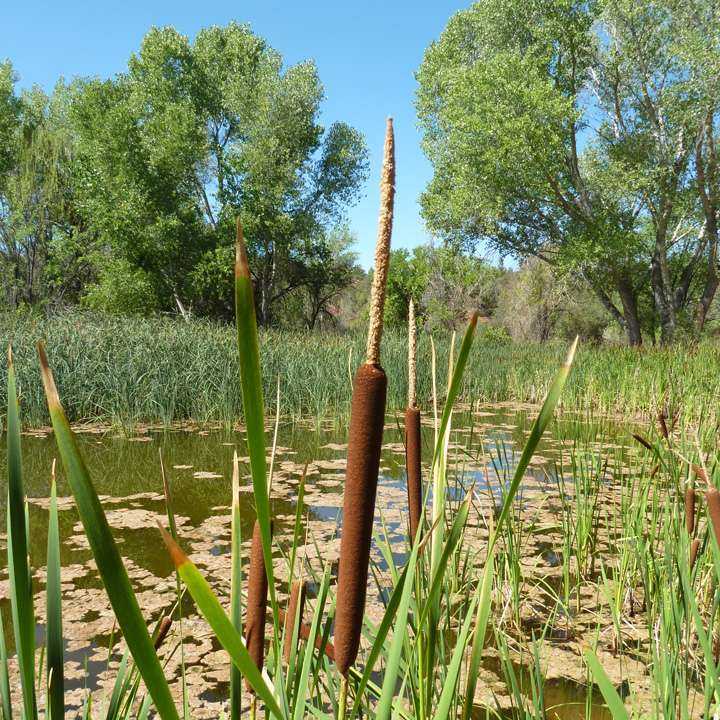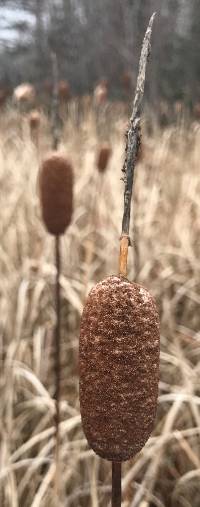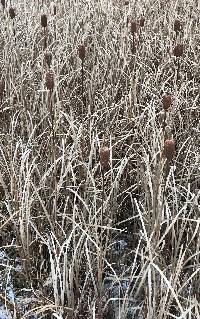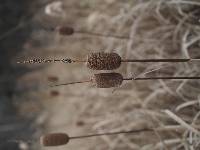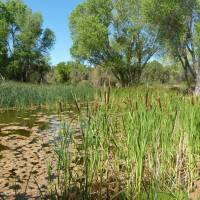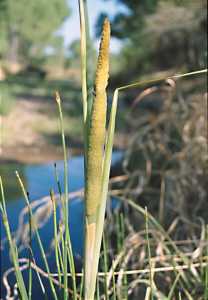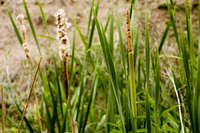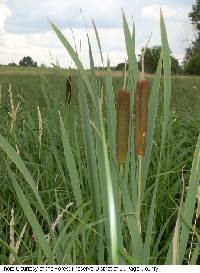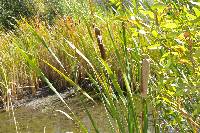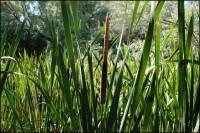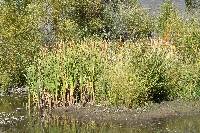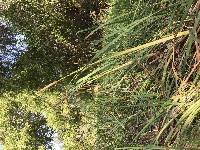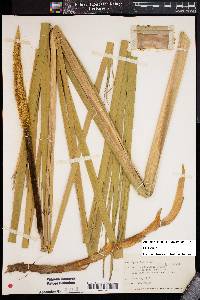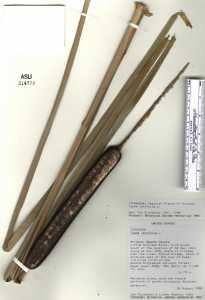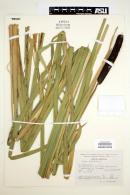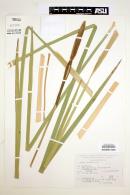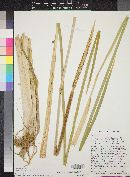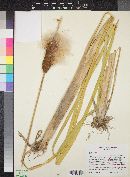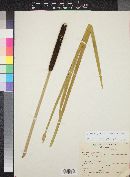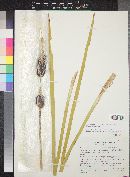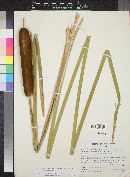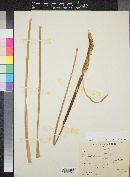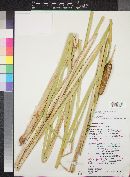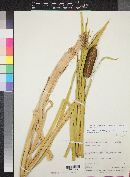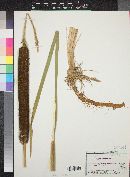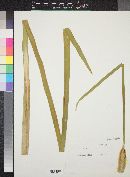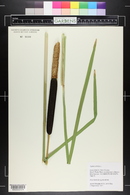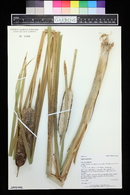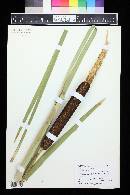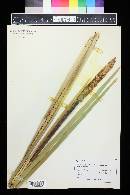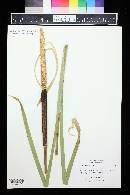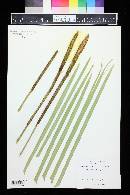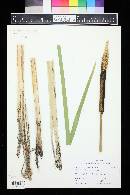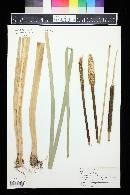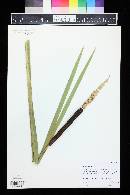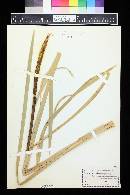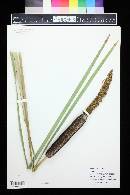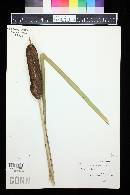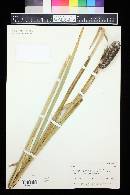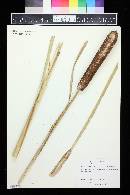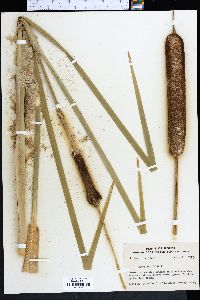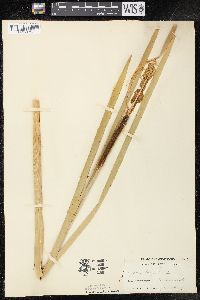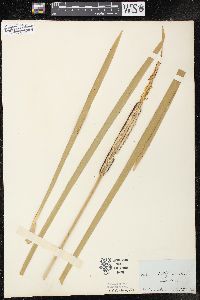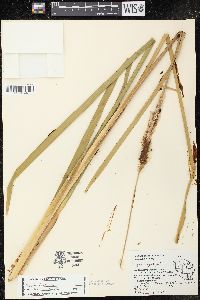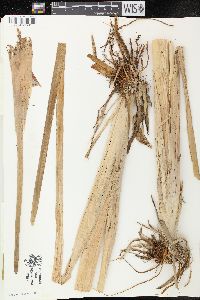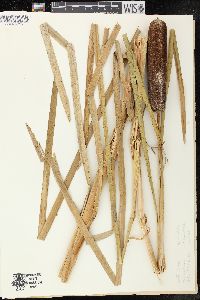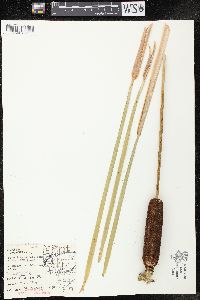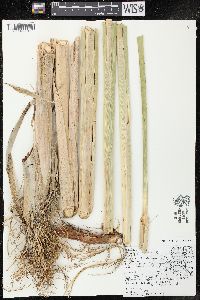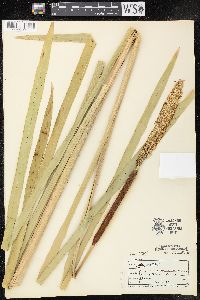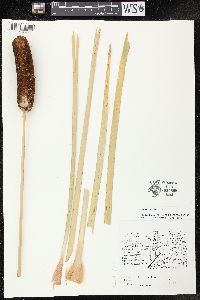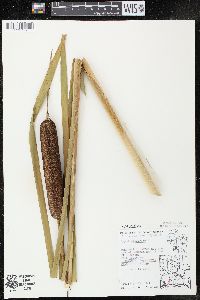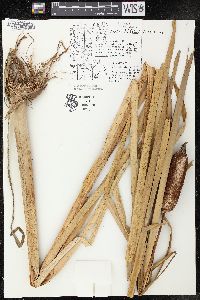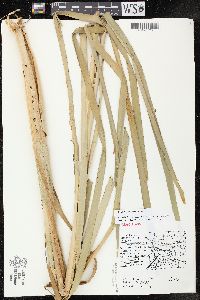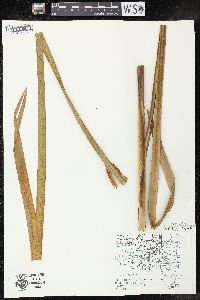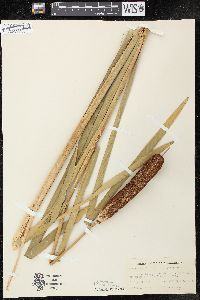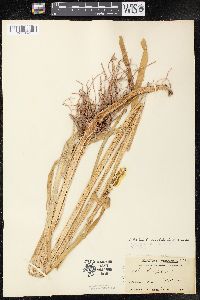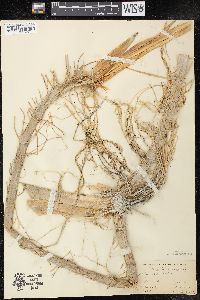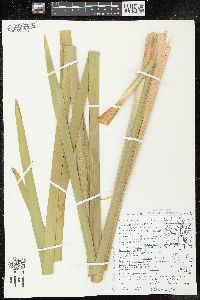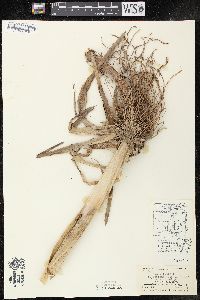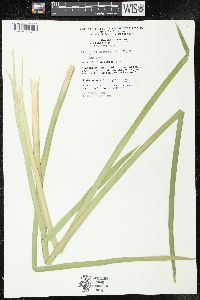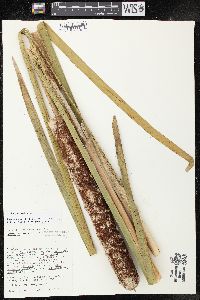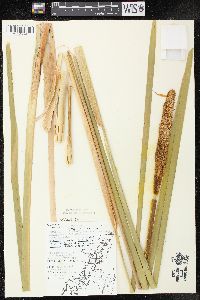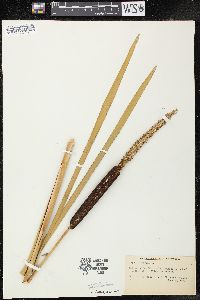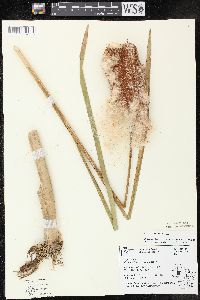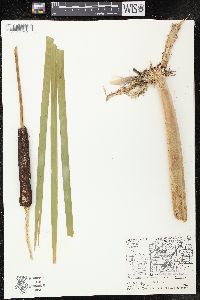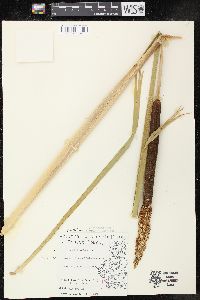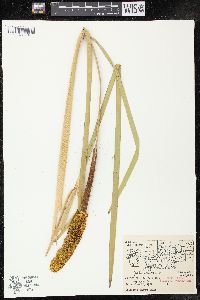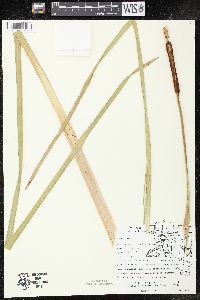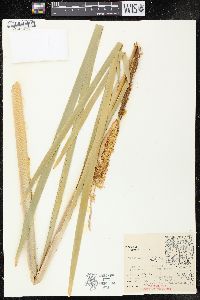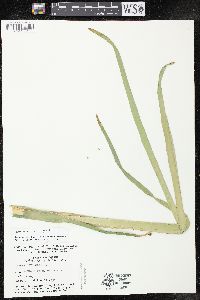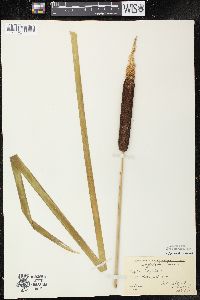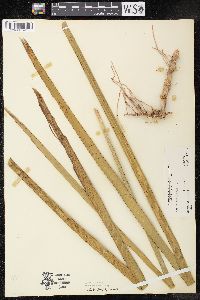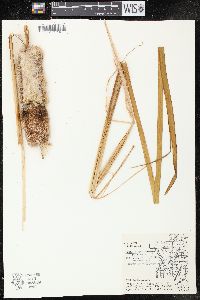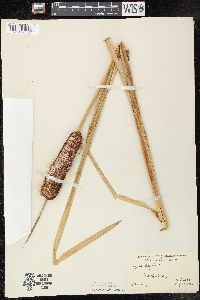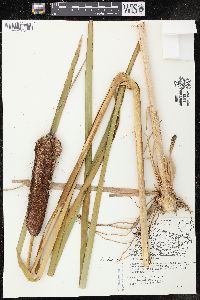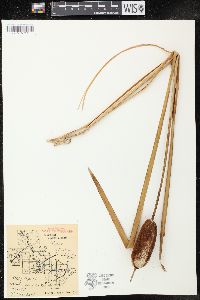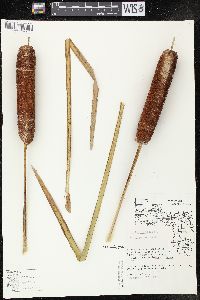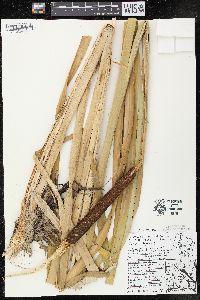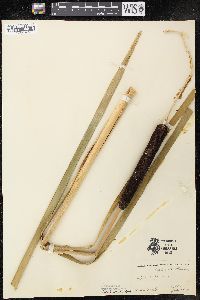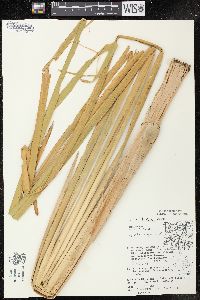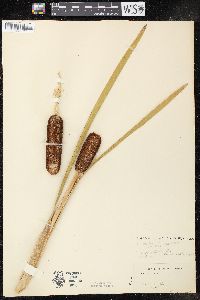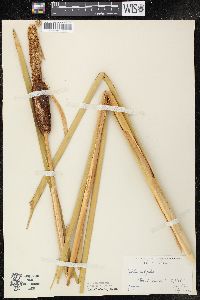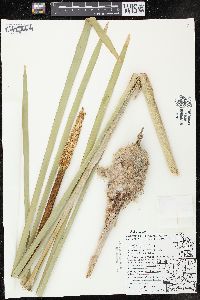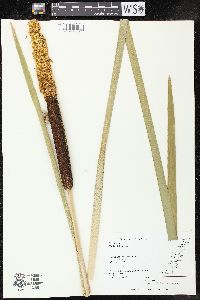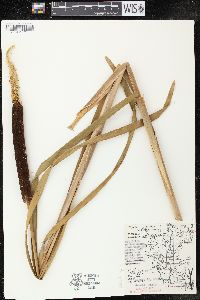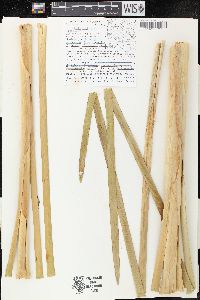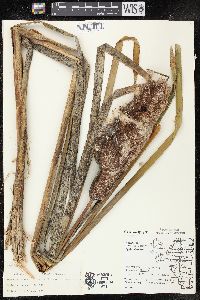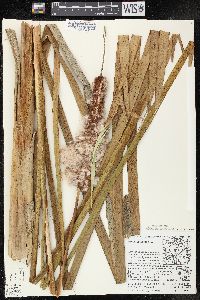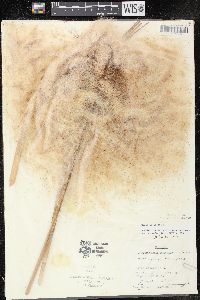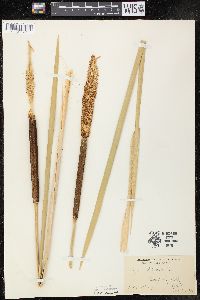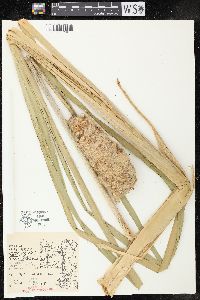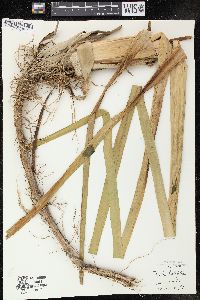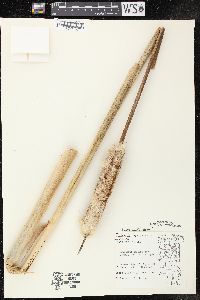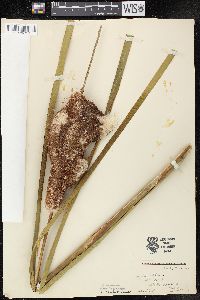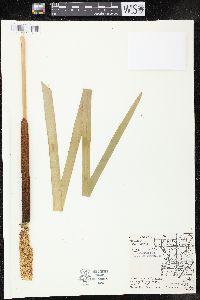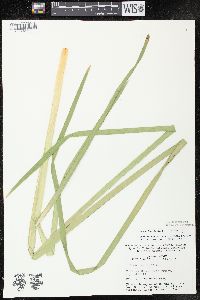Typha latifolia
|
|
|
|
Family: Typhaceae
Broad-Leaf Cat-Tail, more...broadleaf cattail, common cattail, cattail, cattail (common) (es: tule, espadilla, cola de gato, plumillo, maza de agua)
[Typha latifolia f. ambigua (Sond.) Holmb., moreTypha palustris Bubani] |
Erect shoots 150--300 cm; flowering shoots 1--2 cm thick in middle, stems 3--7 mm thick near inflorescence. Leaves: usually glaucous when fresh; sheath sides papery or membranous, margins narrowly clear, summit tapered into blade to distinctly shouldered, or rarely with firm, papery auricles; mucilage glands at sheath-blade transition usually colorless, obscure, absent from sheath center and blade; widest blades on shoot 10--23(--29) mm wide when fresh, 5--20 mm when dry, distal blades about equaling inflorescence. Inflorescences: staminate spikes contiguous with pistillate or in some clones separated by to 4(--8) cm of naked axis, about as long as pistillate, ca. 1--2 cm thick at anthesis; staminate scales colorless to straw-colored, filiform, simple, ca. 4 0.05 mm; pistillate spikes in flower pale green drying brownish, later blackish brown or reddish brown, in fruit often mottled with whitish patches of pistil-hair tips, 5--25 cm 5--8 mm in flower, 24--36 mm thick in fruit; compound pedicels in fruit bristle-like, variable in same spike, 1.5--3.5 mm; pistillate bracteoles absent. Staminate flowers 5--12 mm; anthers 1--3 mm, thecae yellow, apex dark brown; pollen in tetrads. Pistillate flowers 2--3 mm in flower, 10--15 mm in fruit; pistil-hair tips colorless, whitish in mass, not enlarged; stigmas persistent, forming solid layer on spike surface, pale green in flower, drying brownish, then reddish brown or usually distally blackish, spatulate, ovate to ovate-lanceolate, 0.6--1 0.2--0.25 mm; carpodia exceeded by and hidden among pistil hairs, straw-colored, apex rounded. Seeds numerous. 2n = 30. Flowering late spring--summer in north, spring--early summer in south. Fresh to slightly brackish water or wet soil; 0--2300 m; Alta., B.C., Man., N.B., Nfld. and Labr. (Nfld.), N.W.T., N.S., Ont., P.E.I., Que., Sask., Yukon; Ala., Alaska, Ariz., Ark., Calif., Colo., Conn., Del., Fla., Ga., Idaho. Ill., Ind., Iowa., Kans., Ky., La., Maine, Md., Mass., Mich., Minn., Miss., Mo., Mont., Nebr., Nev., N.H., N.J., N.Mex., N.Y., N.C., N.Dak., Ohio, Okla., Oreg., Pa., R.I., S.C., S.Dak., Tenn., Tex., Utah, Vt., Va., Wash., W.Va., Wis., Wyo.; Mexico; Central America; South America; Eurasia; Africa; introduced, Australia (Tasmania (introduced)). The erect shoots of Typha latifolia are more fanlike when young than in other North American species because the proximal leaves (dying by mid season) spread more widely. Undoubtedly native throughout its North American range, where it is often a codominant or minor component of marshes, wet meadows, fens, and other communities. In many places it is apparently being replaced by T. angustifolia and T. angustifolia T. latifolia (T. glauca) at least partly due to human disturbance of habitats. There is a specimen of T. xglauca from Anticosti Island, Quebec. Locally in California and perhaps elsewhere where hybrids are common, the pollen grains of some T. latifolia plants separate slightly and may be shed partly as mixtures of triads, dyads, and monads, perhaps due to introgression ([S. G. Smith, unpublisheddeletion.). Ph.D. thesis]. See also hybrids in key and genus.
Plant: Tall perennial graminoid Leaves: 12-16, light green, 6-23 mm wide, nearly flat, the leaf sheath cylindrical and open to the base, the scarious upper portion tapering or rarely truncate, not auricled INFLORESCENCE: (including stem) 1-3 m tall, as long as or slightly longer than the leaves, the pistillate and staminate portions contiguous, rarely slightly separated; staminate spikes 6-12 cm long, light brown; pistillate spikes dark brown, 10-18 cm long, 1.5-3 cm thick Flowers: STAMINATE FLOWERS: pollen orange or more commonly yellow, in tetrads. PISTILLATE FLOWERS without subtending bracts, on slender almost hair-like "compound pedicels" 1-2 mm long Fruit: FRUITS ellipsoid, 1 mm long, long stalked, minute nutlets, dry, tardily dehiscent, buoyant; SEEDS albuminous, striate, with mealy endosperm Misc: In shallow, slow-moving water of streams, lakes or marshy areas; 1200-2500 m (4000-8200 ft); May-Sep; (fr. Jul-Oct) REFERENCES: Ricketson, Jon. 2001. Sparganiaceae. J. Ariz. - Nev. Acad. Sci. Volume 33(1). Perennial herb 1 - 3 m tall Stem: erect, unbranched, 3 - 7 mm thick near the inflorescence. Leaves: sheathed at the base, long and narrow with the uppermost blade about equalling the inflorescence, 10 - 23 mm wide when fresh, 5 - 20 mm wide when dry, more or less flat, loosely twisted, usually covered in whitish waxy coating when fresh (glaucous). The intersection of the sheath and blade is membranous and rarely has ear-shaped appendages (auricles). Inflorescence: a dense cylindric terminal spike with the male part usually touching or separated above the female part by 4 - 8 mm, both parts about the same length. The male part is about 1 - 2 cm thick, with colorless to straw-colored scales that are about 4 mm long, to 0.05 mm wide and unbranched. Female part pale green changing to brownish and later blackish brown to reddish brown, 5 - 25 cm long, 5 - 8 mm across, becoming 2.4 - 3.6 cm across in fruit. Fruit: a tiny dry follicle borne on a slender stalk, the stalk having many long hairs that do not expand at the tip, each follicle single-seeded. Male flowers: 5 - 12 mm long, with 1 - 3 mm long anthers that are yellow with a dark brown tip and pollen in clusters of four. Female flowers: lacking bracts, 2 - 3 mm long, with whitish pistil-hair tips that are not enlarged and spoon- to egg-shaped stigmas changing from pale green to brownish to reddish brown to blackish. Similar species: The three most common species of Typha in the Chicago area are incredibly similar in gross morphology and one must look at the flowers and fruit (and often pollen) under magnification, and even then the identity may be inconclusive. Recently, DNA technology has become the best tool for distinguishing the taxa. While somewhat variable, the following characters may be used to separate the species, but not in all cases. Typha angustifolia and Typha domingensis each have single pollen grains, lance-linear stigmas, female flower bracts, and inflorescences with the male and female flower parts distinctly separated. Typha x glauca is a hybrid of T. angustifolia and T. latifolia and can often look very much like either or both parents. Certain hybrid crosses produce individuals with attributes intermediate to the parents. It is unreliable, but in the hybrid the female part of the inflorescence is often longer than 16 cm. Flowering: June Habitat and ecology: Prior to settlement by Europeans this was the only cattail species in the Chicago Region. It was much more common in the past than in the last several decades. Sadly our native cattail has become almost extirpated from the Chicago Region and replaced by almost solid stands of the hybrid T. x glauca or the introduced T. angustifolia. Some research indicates T. latifolia could not compete because its pollen matures later than the introduced species and this provided the non-natives with a competitive advantage in pollination and reproduction. Occurence in the Chicago region: native Etymology: Typha comes from the word typhe, the old Greek name for cat-tail. Latifolia means broad-leaved. Author: The Morton Arboretum Ricketson 2001, FNA 2000 Common Name: broadleaf cattail Duration: Perennial Nativity: Native Lifeform: Forb/Herb General: Perennial herbaceous graminoid, 1-3 m tall, from extensive creeping rhizomes; stems erect, cylindric and pithy. Vegetative: Leaves alternate along the stems, with sheathing bases; 12-16 leaves per stem; sheaths cylindric and open to the base, with scarious margins that taper to the blade or are rarely truncate; blades thick and spongy, light green, 6-23 mm wide, about as long as the stems or a little shorter, and nearly flat. Inflorescence: Male spike, 6-12 cm long, is located at the top of the stem, and the female spike, 10-18 cm long and 15-30 mm diameter, is located just below the male spike on the same stem, without any bare stem (or less than 1 cm of bare stem) between the male and female spikes; spikes are cylindrical, with hundreds of tiny flowers packed together; flowers lack petals and sepals; male flowers are light brown, release copious yellow to orange pollen when touched, and are ephemeral (falling off the stem soon after pollen is distributed); female spikes are dark brown; when mature, tiny seeds and accompanying long filiform hairs are released from female spikes in large clumps. Ecology: Found in slow moving water and marshy areas, from 4,000-8,500 ft (1219-2591 m); flowers May-September. Distribution: Throughout N. Amer. from AK and CAN south to MEX; south to S. Amer.; also in Eurasia and Africa; introduced in Tasmania. Notes: This is the common cattail of the Rocky Mountains, which occurs in the Southwest at higher elevations. Distinguish from T. domingensis, the cattail of lower elevations in the US Southwest, based on T. latifolia's wider, flat, light green leaves, 6-23 mm wide; the dark brown female spike; and the fact that there is no gap of bare stem between the male and female spikes. T. domingensis has narrower leaves on average, 6-12 mm wide, which are light yellowish-green and slightly crescent-shaped in cross section; the female spikes are light brown; and there is a 1-4 cm gap of bare stem between the male and female spikes. Ethnobotany: Young stalks, roots, and seeds were eaten as food; used for thatch in houses, weirs, sandals, and clothing; the fluffy absorbant seeds were used in early versions of baby diapers and menstrual pads; a poultice was made of the crushed roots and used to treat sores, infections, bleeding wounds, burns and scalds; also used ceremonially. Etymology: Typha is derived from the Greek word typhe, marsh or fen, alluding to the plant's habitat; latifolia means broad-leaved. Synonyms: None Editor: SBuckley 2010, AHazelton 2017 Stems 1-3 m; lvs flat, (8-)10-23 mm wide; pistillate and staminate portions of the spike contiguous, or rarely separated by as much as 4 mm, the pistillate portion brown, 10-15 cm, 2-3 cm thick at maturity; compound pedicels long and slender; pistillate bracteoles wanting; stigma broad and thick, spatulate; fr 1 cm, with copious white hairs arising near the base (these linear, not expanded upwards), the achene 1 mm long, above the middle of the whole fr; sterile pistillate fls about as long as the fertile and similarly hairy, expanded into a spatulate tip; staminate bracteoles white, capillary; pollen in tetrads; 2n=30. Clean marshes; nearly cosmop., and throughout our range, the common sp. inland. Hybrids with the next 2 spp. have been called T. اlauca Godr. Gleason, Henry A. & Cronquist, Arthur J. 1991. Manual of vascular plants of northeastern United States and adjacent Canada. lxxv + 910 pp. ©The New York Botanical Garden. All rights reserved. Used by permission. From Flora of Indiana (1940) by Charles C. Deam Found in ditches, ponds, marshes, gravel pits, and marshy places about lakes and along streams. It is frequent in the lake area, becoming infrequent to local in the southern part of the state where its habitat is rarely found. …… Indiana Coefficient of Conservatism: C = 1 Wetland Indicator Status: OBL |
|
|
|

